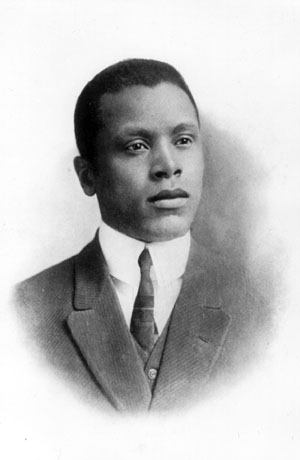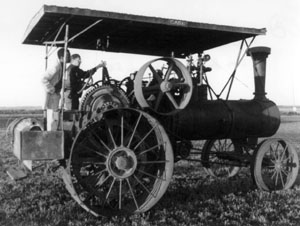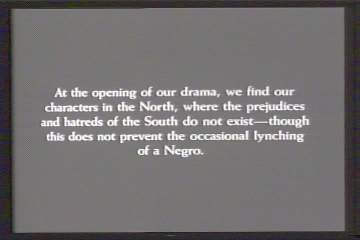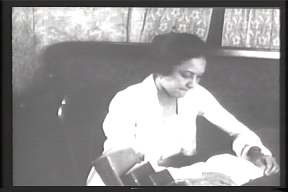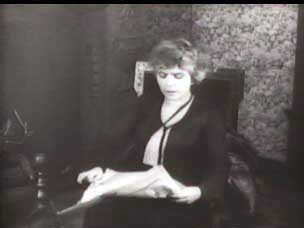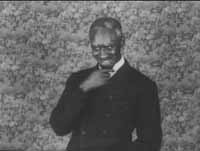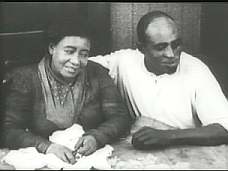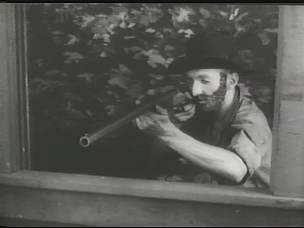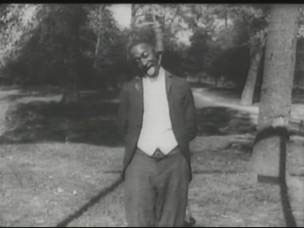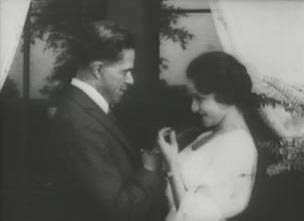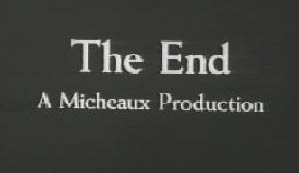Within Our Gates.
|
Micheaux produced his films during a time of great change in the African-American community. The economic opportunities made available to black workers during World War I unleashed a surge of African-American migration; between 1917 and 1920, high paying urban jobs induced 700,000 to 1,000,000 African Americans to leave the poverty and serf-like conditions of the South. Another 800,000 to 1,000,000 African-Americans left during the decade of the 1920's. While the pre-war migration of blacks had primarily been to southern urban areas, the new migration was to northern cities like Detroit, Chicago, and New York City.[1]
There were both pushes and pulls out of the South. As W.E. B. DuBois wrote in June, 1917, "As to the reasons of the migration, undoubtedly, the immediate cause was economic, and the movement began because of floods . . . [and] the boll weevil. [In] back of them is, undoubtedly, the general dissatisfaction with the conditions in the South." Du Bois then listed a series of grievances he had collected from new transplants which they had against their former region. These included the inability to vote, the fear of lynching, "bad treatment," the lack of education, and discrimination.[2]
Besides higher wages, the North also promised the franchise and better social conditions. The concentration of large numbers of African-Americans in northern locations aided in the proliferation of self-help organizations such as the Urban League, the N.A.A.C.P. and the Negro Business League. It also fueled artistic revolutions such as the Harlem Renaissance. Large urban African-American communities provided a ready-made audience for motion picture directors like Oscar Micheaux.
Micheaux was born in Metropolis, Illinois in 1883, one of the first generation of African-Americans born into freedom. His father was a farmer and his mother was a schoolteacher. They implanted three ideas in the young boy's mind that would be valuable messages of his own - the importance of owning your own land, respect for farming as a profession, and the value of education.[3]
|
In 1910, he married Orlean McCracken. The marriage was doomed from the beginning. The death of a child, Orlean's loneliness on the farm, and increasing economic problems led to a permanent separation. Orlean's minister-father eventually brought her back to Chicago.[4]
Three years later, in 1913, Micheaux wrote and published his first novel, entitled The Conquest. Having a limited education, Oscar was largely self-taught. According to Henry T. Sampson, he began writing as a form of therapy.[5]. His homesteading venture became a financial disaster and his marriage was a failure. After the publication of The Conquest, Micheaux switched careers, believing he could earn a living as a novelist. In the following four years, and before his filmmaking debut, he published two more books, The Forged Note (1915) and The Homesteader (1917). Both books drew heavily upon his experiences in Chicago and on the farm in South Dakota. The novels were partially autobiographical. Micheaux was clearly manipulating and exploiting his life experiences; he rewrote his own biography to illustrate his philosophies on manhood and race.
The popularity of The Homesteader eventually drew the attention of George P. Johnson, booking manager of the Lincoln Motion Picture Company, a successful black film production company. The Lincoln company expressed interest in filming the novel but during negotiations Micheaux decided he should supervise the motion picture production in Los Angeles. This was not acceptable to the Lincoln management and ultimately led to the formation of the author's own firm, the Micheaux Film and Book Company.
Throughout the silent era, Micheaux created cinematic portrayals of African-American manhood that stood in sharp contrast to Hollywood's depictions. Mainstream film companies portrayed black men largely as humorous objects—dim witted, slow moving, shiftless caricatures who were non-threatening to the mainstream white public audience. Most black-owned film companies of the post-World War I era�including the Frederick Douglas Film Corporation, the Unique Film Company, and the Rosebud Film Corporation�depicted African-American men in stark and melodramatic contrasts of good and evil, as either epitomes of virtue or dastardly ogres.[6] While these companies attempted to illustrate desirable characteristics of black manhood, they did so in unrealistic ways that did not consider the economic, political and social frustrations that African-American men faced on a daily basis. Thus, saint-like figures proved to be impossible role models for urban or rural African-American men to live up to.
It was not difficult to figure out who symbolized the "good" or "bad" examples of black manhood in Micheaux's films. As in his novels, Micheaux attempted to demonstrate the qualities needed to be a successful man. He had written, in The Homesteader, "[The] race needed examples; they needed instances of successes."[7] But Micheaux also explored the motivation behind the negative characteristics of some African-American men. As Bell Hooks argues, "He was not concerned with a simple reduction of black representation to a positive image".[8] All the dirty laundry of African-American masculinity was aired in Micheaux's cinema: gambling, drugs, passing for white, conspiring with white men for selfish advancement, and criminality. Oscar Micheaux stood out as unique among African-American filmmakers because he went beyond the idealization of black manhood that was so prevalent in the work of his peers. He called upon African-American men to question their own activities and morals, warts and all.
Two themes—the exposure of racial hostility and prejudice toward African-Americans, and alternative depictions of black manhood—were most prominent in Micheaux's second film, Within Our Gates. The film was one of his most scandalous. Criticized by segments of both the black and white communities, the film had numerous censorship problems. It was certainly Micheaux at his most provocative. The film was released shortly after a summer of race riots in 1919 and the timeliness of the film, in regards to racial sensitivity, played into Micheaux's problems with its exhibition.[9]
A single surviving print of the film was found in Spain in the 1980's, retitled La Negra. The original English intertitles were lost, except in four cases. The film has since been restored by the Library of Congress but the intertitles on the restoration only approximate Micheaux's originals. The titles were originally in English, translated into Spanish, and then back into English; thus, African-American syntax and slang often were eliminated.[10] The discovery of Within Our Gates is significant because it remains the oldest surviving example of African-American feature filmmaking. It is also critical to understanding Micheaux's oeuvre because of the many ways he reworked the film after filming it (often cutting out controversial scenes or butchering the original product).[11]
The print of Within Our Gates now available to the public is not the original film which Micheaux screened for film audiences in January, 1920. The surviving print is remarkably radical considering contemporary cinematic discourse among African-American filmmakers of the era. As Micheaux scholar Jane Gaines noted, the problem that D. W. Griffith's The Birth of a Nation had with censorship was that it told a completely fabricated version of American history. Within Our Gates, on the other hand, was criticized and censored because it told too much truth.[12] Because it stood as a counterpoint to Birth of a Nation and because the it so powerfully presented Micheaux's view of black manhood, a detailed analysis of Within Our Gates helps establish Micheaux's significant contributions to American cinema, African-American cinema, and our understanding of changing protrayals of black manhood in film.
|
|
The first half of the film centers on Piney Woods, "far from all civilizations and in the depth of the forests of the South where ignorance and the lynch law reign supreme." Micheaux clearly points out the geographic distinctions in racial prejudice in the United States. While Micheaux encouraged African-Americans to migrate to the West rather than to the North, he clearly illustrated the racial hostility blacks faced in the South.
The viewer is soon introduced to Reverend Wilson Jacobs, the founder of a school for African-Americans and "[an] apostle of education for the black race." Micheaux demonstrates the lack of educational opportunities available to African-American children in the South. Shortly after Sylvia arrives in Piney Woods intertitles explain the challenges faced by Reverand Jacobs and Landry—reaching and teaching others who arrived at Piney Woods, "others . . . who could not read." A dark-skinned farmer and his two small children walk into Reverend Jacobs' office. The farmer explains that boll weevils have eaten up his cotton crop (a very real problem in the 1910's) and since he could not pay his rent, his mule was taken away. He explains further, "I hears 'bout your school 'n so we walked from my place, aways off, cause my children don't do nothin' but say 'Papa without schoolin' we c'n never mount to nothin.' So her I is, ready to work day n'night so's my children can go to school." The use of dialect is not meant to be derogatory. It is realistic in the context of its portrayal of a poor uneducated sharecropper and his willingness to go to extreme measures to give his children a future. While other African-American filmmakers of the period ridiculed the poor black southerner, Micheaux held him up as a model, a poor man who was sacrificing for the future of his family.[15] His desire is that his children be educated so that they will have a better life than he does—the American dream. Many white Americans believed African-Americans were too lazy or stupid to want an education; this sort of scene never appeared in mainstream white productions of the period.
Reverend Jacobs explains to Sylvia that the school is just about out of money. New students have to be turned away every day because of the lack of funds. Sylvia decides that she must raise money for the school. With her bags packed, she tells Wilson, "It is my duty and the duty of each member of our race to destroy ignorance and superstition." The film then introduces Dr. V. Vivian (Charles Du Lucas), a man "passionately engaged in social questions," who is about to meet Sylvia while rescuing her from a thief.[16] He is reading the Literary Digest and the camera focuses on the passage he is reading. This is critical because several times throughout the film Micheaux shows us what Dr. Vivian is studying; this serves as a proxy for Micheaux's point-of-view. The passage reads: "Reverend Thurston has begun an active campaign for the education of the black race. He asks that the federal government contribute significantly, so that Negro children in all of the U.S. can receive proper instruction." Thus, Micheaux addresses a serious contemporary problem which virtually all filmmakers of the period, both black and white, ignored.
|
Sylvia has little luck raising funds until she quite accidentally meets a wealthy white female philanthropist, Mrs. Elena Warwick, who hits her with her automobile! Sylvia explains the Piney Woods school financial crisis. Mrs. Warwick then approaches Geraldine for advice about the matter and she espouses a litany of reasons why it is foolish for Mrs. Warwick to donate money for black education. She argues that black men are nothing more than "lumberjacks and field hands" and claims "thinking would only give them a headache." This white bigot represents traditional racist arguments which support discrimination and prejudice. Micheaux is quite subversive here by making Geraldine the point of ridicule. As a symbol of southern bigotry she is the "irregular" member of the cast. Geraldine suggests to Mrs. Warwick that rather than spend $5000 on black education she should give $100 to Old Ned "the best colored preacher in the world."
It seemed almost impossible for Micheaux not to include a negative portrayal of black preachers in his film. Micheaux viewed traditional black religiosity (and the men who conduct its dogma) as dangerous to African-American freedom and advancement. Geraldine explains, "Old Ned will do more to keep Negroes in their place than all your schools put together." The film begins a five minutes segment criticizing Old Ned and the black religious community. Members of black churches complained bitterly about these depictions. Old Ned is clearly an Uncle Tom but he is not an evil man. In fact, Micheaux goes to great lengths to make him a tragic figure trapped by the racial system in which he exists. Old Ned preaches to his congregation that "white folks with all their schooling, all their wealth, will most all fall into the everlasting inferno, while our race, lacking these vices and whose souls are more pure, most all will ascend to heaven."
|
The film then proceeds along a second storyline, a lengthy flashback. Alma Prichard, Sylvia's northern cousin—who was secretly in love with Sylvia's fiance, Conrad Drebert and who sought to encourage Sylvia and Conrad's estrangement from one another—has undergone a transformation; she now deeply regrets her actions. In a conversation with Dr. Vivian, Alma reveals Sylvia's tragic past. Her stark description—depicted cinematically—of the destruction of Sylvia's family allows Micheaux to address one of the most volatile and controversial topics of his era: Negro lynching. This segment of the film is also the most action-packed and racially confrontational.
|
Jasper works the land of Philip Gridlestone. Described as a "modern Nero, feared by the Negroes [and] envied and hated by the white farmers," Gridlestone has been stealing from his sharecroppers for years. Their lack of education has allowed him to juggle the books to his financial advantage. Gridlestone is assisted by Efrem, his gossipy servant, who—in many ways—is the most despicable of the African-American male characters in Michaeux's film. He is an "incorrigible" tattletale, one or frequently drinks his "master's" liquor, and whose only "pleasure was to take from one place to another" any gossip he could obtain.
Sylvia is determined that she will no longer allow her sacrificing father to be robbed by Gridlestone so she carefully manages her father's accounts so he can settle without argument. That afternoon, Jasper enters the back of Gridlestone's house and goes into his office. Gridlestone looks upon Jasper with disgust while Efrem, the spy, is snooping outside the window. Gridlestone warns Jasper, "You're getting mighty smart, eh. I'm on to you. And remember the white man makes the law in this country." At this point a poor white man comes to the window with a gun. The title reads: "Yes, Gridlestone has cheated him also and when he called him to terms had laughed in his face, calling him Poor White Trash - and no better than a Negro"
|
Efrem gleefully rushes to spread the news, going to all of the white shops in town explaining that Jasper has killed Mastah Gridlestone. For this reason, the film argues, he was known as the white man's friend. White men start to gather on the city sidewalks to discuss the matter. Landry gets his family, their belongings, and his gun, and they run off to the swamps, attempting to escape through a a terrific rainstorm. Mobs of white men and boys set out on foot to capture the family. The manhunt continues for more than a week. Micheaux goes to great lengths to portray this mob as being made up of poor white men. He truly evokes a mob mentality when the real killer of Gridlestone is accidentally killed by some of the searchers—a victim of circumstances. Efrem is in his full glory. "Tain' no doubt 'bout it - da whi' folks love me," he says to himself. All around him though, white people are growing impatient. "Here I is 'mung da whit flk while dem other niggahs hide in da woods," he thinks. Suddenly Efrem looks around nervously. "While we's wait'n what ya say we grab this boy," says one of the white men, referring to Efrem. "But you know me mastah John - I's the one who tells you." It makes no difference. Efrem is taken away—and lynched.
|
The same newspaper account gives a distorted view of the scene between Landry and Gridlestone. Reenacting the false newspaper account, Landry is shown chasing Gridlestone around the room while the white man, wounded, begs him for mercy. He falls to the ground and then the "savage Negro" beats him. Micheaux intricately demonstrates how the press, the system of law and order, and those in economic power all worked together to trap black men. He also illustrates how the lynching of black men had become part of consumer culture, a spectacle to be regarded as entertainment, news, and racial justification for violence by the white public.
Jasper Landry, his wife, and son are finally captured. The "Committee," a crazed vigilante group of white citizens, march the family to their place of execution on Sunday, the Lord's day. With clubs in their hands, the barbaric mob takes Mrs. Landry and beats her, while one man strips off her dress. Landry tries to choke the white man who humiliates his wife. What follows is a superbly chilling succession of shots in which Micheaux shows the fate of the Landry family. A shot-by-shot analysis is necessary to demonstrate the unsettling artistry which Micheaux uses to shock his audience.
- Shot 1 shows a lynching rope swinging in the breeze.
- Shot 2 shows Mrs. Landry grabbing her boy, trying to protect him.
- Shot 3, the single most damning of the entire film, shows the mob placing a noose around ten-year old Emil's neck. It is a remarkable indictment of the travesty of southern justice.
- Shot 4 shows a noose being placed around Jasper Landry's neck.
- Shot 5 shows the boy running away as the mob prepares to kill his father. The men shoot at Emil and he falls, wounded, prostrate on the ground.[20]
- Shot 6, in a relieving moment, demonstrates that the boy has faked his death. He runs away and steals a horse while the crowd continues to shoot at him.
- Shot 7 shows both man and wife with ropes around their neck.
- Shot 8 displays the white men pulling the ropes.
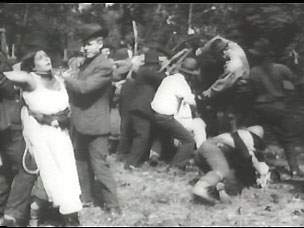
|
|
The murder of the Landry family. From Within Our Gates. |
The final shot shows these same men placing kindling around the lynching posts.
|
Micheaux then crosscuts the film, alternating the lynching scene with an attempted rape of Sylvia. She is trapped in a house with Armand Gridlestone, Philip's brother. A title reads: "Still not satisfied with the poor victims burned in the bonfire, Gridlestone goes looking for Sylvia." Micheaux interweaves scenes of the demise of the Landry family with the molestation of Sylvia, implying they are happening at the same time. The scenes read as follows:
- Scene 1 - Gridlestone chases Sylvia around the room
- Scene 2 - The mob cut down the lynching ropes.
- Scene 3 - Gridlestone rips off Sylvia's coat.
- Scene 4 - The mob starts burning the lynched bodies.
- Scene 5 - Sylvia grabs a knife and frantically fights for her life.
- Scene 6 - A huge burning bonfire in the night consumer the Landry's remains.
- Scene 7 - Sylvia gives up after a terrific fight.
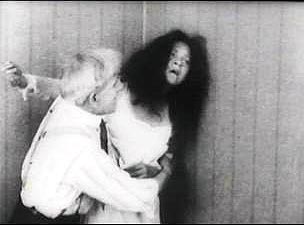
|
|
Armand Gridlestone attempts to rape |
Jane Gaines argues that the utilization of cross-cutting techniques in the melodramatic form has special meaning for the disenfranchised spectator because of the way the device is used to inscribe power relations. The lynching of the Landry family and the possible rape of Sylvia placed the contemporary African-American spectator in a totally hopeless position, made all too painful due to the recognition that these things happened in the real world. Gaines also argues that this editing technique empowers the minority spectator by awarding them moral superiority, demonstrating that they recognize the injustice and cruelty evident on the screen.[23] This dramatic scene is remarkably structured like the final climax of Griffith's The Birth of a Nation. While Micheaux never publicly commented on The Birth of a Nation the structural and thematic parallels are evident. In The Birth of a Nation it is a mob of black soldiers that threaten the white leading characters which the audience is supposed to identify with. In Within Our Gates it is a lynch mob of whites that threaten the major black figures.
Post-structuralist film theory helps to explain racial difference in regards to spectatorial positioning. A film spectator can accept, negate or reject the system of power relations depicted on the screen. This gives the spectator a privileged position. While the viewer is limited by the cinematic text on the screen, he or she is in the position to accept or reject the film narrative and its issues of hegemony.
Black British cultural theorist Stuart Hall has emphasized the relationship between the encoding function of the filmmaker and the decoding function of the spectator. He has argued that "the relationship between the ideology contained within texts and the various ways in which individuals 'decode' or interpret that ideology is based on their own social positioning."[24] Thus, an African-American spectator in 1920 was likely to reject the ideological underpinnings of The Birth of a Nation and accept the social message of Within Our Gates.
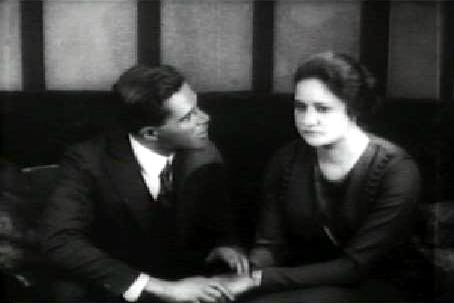
|
|
Dr. Vivian and Sylvia in the final scene of Within Our Gates. |
But he continues, "And you Sylvia have been thinking deeply about this I know but unfortunately your thoughts have been warped. In spite of all your misfortunes you will always be a patriot and a wife." The film then ends with a title explaining that Sylvia realized that Dr. Vivian was right after all.
How can the viewer explain this three hundred and sixty degree turn in political attitudes? How could all of these crimes against Sylvia's family be excused? Why was Micheaux trying to sweep the problems he had so clearly laid out for the viewer under the rug?
There are two obvious answers. Micheaux may have been an apologist for white America. Certainly there are passages within in his novels which would be considered racially offensive today. Micheaux castigated many members of his own race. He claimed in his novel The Homesteader, "Some of the race [African-American] are very ignorant and vicious."[25]
Micheaux may have been the epitome of bourgeois black values, ignoring the realities of poor black Southerners. He believed that only a minority of African-Americans were practical, responsible, and moral while the overwhelming majority were impractical, immoral and immature.[26] But this did not mean that he was alone. Alain Locke, professor of philosophy at Howard University and spokesman for the Harlem Renaissance, argued in 1927, " I would so much prefer to see the black masses going gradually forward under the leadership of a recognized and representative and responsible elite than see a frustrated group of malcontents later hurl these masses at society in doubtful but desperate strife."[27] Members of the Talented Tenth often had contempt for poorer African-Americans, particularly newly migrated Southerners. They saw themselves as leaders of the New Negro movement. Micheaux and Locke both believed that their examples and those illustrated in their art should serve as inspiration for those in their race, particularly the masses.
But the question remains - Why would Micheaux choose to be so painfully provocative, only to cloak racial injustice with patriotism and war victory?
Micheaux may have added the final scene in the film after censorship problems. The film was initially turned down by the Chicago Board of Censors for its graphic display of lynching. Micheaux provided a frank discussion of some of the racial problems in American society; certainly other filmmakers would have encountered censorship problems with the same material. Micheaux may have added this final scene as a way to possibly avoid problems with the multitude of state and municipal motion picture censorship boards that were operating at the time. He was notorious for editing and then re-inserting scenes in his films to get around the censors.
There may have also been a third reason for this final scene. The film was clearly a product of its times. Produced during the "Red Summer" of 1919, Within Our Gates was a powerful indictment of the immense racial tension that existed in the postwar era. The epilogue may have been a call for peace and an end to violence, of which African-Americans were the principal victims.
Chicago, where the film premiered, had been wracked by a terrible race riot the previous summer. In addition, between April and October of 1919, over 25 race riots had taken place in towns and cities across the United States, in both southern and northern locations. Many white urban dwellers resented the burgeoning black community. As Micheaux accurately accounts in his opening title, racial violence was no longer unique to the South.[28]
|
|
Micheaux included three negative portrayals of black manhood in Within Our Gates - Larry (Alma's brother), Old Ned, and Efrem. They were not simply depicted as "evil" or "bad" characters though. Micheaux attempted to impart a lesson with each male character. Larry, an urban con-man, chose crime rather than work and was willing to exploit members of his own race to meet his needs. He discovered that crime simply did not pay and his eventual fate was death. Old Ned, the preacher, was a tortured man. Ready to warp traditional Christian practices "to get him a bit of the pottage," Old Ned was also aware of the results of his actions. A tragic figure, he represented the humiliation that black men endured when they stooped for the white man and "yes sahed" their way into submission. Efrem was a variation of the Uncle Tom character. More dangerous than Old Ned, Efrem was ready to willingly sacrifice members of his own race to gain acceptance from the white community. Efrem was completely devoid of racial loyalty and eventually became the victim of his own displaced allegiances. Committed to the white man, he found the relationship was not mutual. The terror in his eyes was more evident when the pitiful figure realized he would be the next black male victim to be sacrificed at the altar of white male barbarism.
|
-
Joe Trotter, "Migration," Encyclopedia of African-American Culture and History,
volume 4, Eds. Salzman, Smith,, West. (New York: Simon and Schuster, 1996), 1781.
[Return]
- Crisis (June 1917). [Return]
- Henry T. Sampson, Blacks in Black and White: A Source Book on Black Film (New York: Scarecrow, 1995), 142-143. [Return]
- Apparently, Reverend McCracken's actions and character totally infuriated Micheaux. Despicable minister figures, most likely modeled after his father-in-law, would appear in a number of his films. [Return]
- Sampson, Blacks in Black and White, 146. [Return]
- Gerald Butters, "Portrayals of Black Masculinity in American Silent Film, 1896-1929" (Ph.D. Diss., University of Kansas, 1999), 185-229. [Return]
- Oscar Micheaux, The Homesteader (College Park: McGrath Publishing, 1969), 109. [Return]
- Bell Hooks, "Micheaux: Celebrating Blackness." Black American Literature Forum 25(Summer 1991): 351-360. [Return]
- The eight-reel film was produced in 1919 and released in Chicago and Detroit in January, 1920. [Return]
- Preface to restored version of Within Our Gates (Washington, D.C.: Library of Congress). [Return]
- Bernard L. Peterson, Jr., "The Films of Oscar Micheaux: America's First Fabulous Black Filmmaker." The Crisis 86 (April 1979), 138. [Return]
- Jane Gaines, "Race, Melodrama and Oscar Micheaux" in Black American Cinema,Ed. Manthia Diawara (New York: Routledge, 1993), 50. [Return]
- W. Fitzhugh Brundage, Lynching in the New South (Urbana: University of Illinois Press, 1993), 8. [Return]
- William Tuttle, Race Riot: Chicago in the Red Summer of 1919 (New York: Antheum Press, 1970), 14-15. [Return]
- A number of African-American directors of the silent era ridiculed the rural black population. Uncle Remus's First Visit to New York (Hunter Haynes Photoplay Company, 1914) involved the title character and his wife who suffer a series of misadventures in New York City due to their inexperience in dealing with the modern trappings of life. In Why Worry (Lone Star Motion Picture Producers, 1923) the leading characters are also "dumb rural hicks" who come to the big city. [Return]
- Lucas also starred in Micheaux's first film, The Homesteader. A very light-skinned, handsome leading man with "good" hair and a strong physique, he was the classic Micheaux hero figure. [Return]
- Joel Williamson, The Crucible of Race: Black-White Relations in the American South Since Emancipation (New York: Oxford University Press, 1984), 379. [Return]
- Lawrence W. Levine, Black Culture and Black Consciousness (New York: Oxford University Press, 1977), xiii. [Return]
- Grace Elizabeth Hale, Making Whiteness: The Culture of Segregation in the South, 1890-1940 (New York: Pantheon Books, 1998), 199-240. [Return]
- One can only imagine the horror in the African-American audience as this scene was being exhibited. [Return]
- Chicago Defender (January 10, 1920), 6. [Return]
- Hale, Making Whiteness, 204. [Return]
- Jane Gaines, "Race, Melodrama and Oscar Micheaux" in Black American Cinema, Ed. Manthia Diawara (New York: Routledge, 1993), 57. [Return]
- Hale, Making Whiteness, 17. [Return]
- Micheaux, "The Homesteader," 59. [Return]
- Joseph A. Young, Black Novelist As White Racist: The Myth of Black Inferiority in the Novels of Oscar Micheaux (New York: Greenwood Press, 1989), 26. [Return]
- Alain Locke, "High Cost of Prejudice," Forum 78 (October 1927), 510. [Return]
- Tuttle, Race Riot, 14-15. [Return]
- Young, Black Novelist As White Racist, 139-141. [Return]
- Chicago Defender (January 3, 1920), 1. [Return]
- Charlene Regester, "Oscar Micheaux's Multifaceted Portrayals of the African- American Male: The Good, The Bad and the Ugly" in Me Jane: Masculinity, Movies and Women, Eds. Pat Kirkhamt and Janet Thumin (London: Lawrence and Wishart, 1995), 175. [Return]
~ End ~ Homestead to Lynch Mob: Portrayals of Black Masculinity.
Copyright © 2000 by The Journal for MultiMedia History
Comments | JMMH Contents - Crisis (June 1917). [Return]
